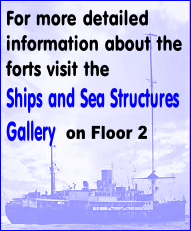© 2014-

My first sight of Knock John Tower was from aboard the Radio Essex tender, a fishing boat called Kestrel.
This was early in 1966, the station had been on air since October the previous year during which time the fort had been adapted from an empty shell into a small local radio station. Access was via a badly leaning landing stage, largely covered in slime and seaweed, from there a rope was lowered and a loop passed around your waist then you were hauled up a further 20ft to the platform. When you have no idea who is doing the pulling it could be a daunting experience for newcomers.
Over the years while the fort had been unoccupied almost everything of value had been stolen, this included the original portholes, toilet and baths, light switches and numerous articles in the two generator rooms. Some heavy things like an industrial oil fired cooker and the kitchen sink remained, even though the taps and plumbing had gone. The original lifts, one in each leg, were both in the 'basement' owing to the theft of the electric motors that powered them, old doors had been placed over the opening to prevent anyone falling all the way down.
The Radio Essex Fort Captain, Dick Palmer, gave new arrivals a tour of the tower, with the original World War 2 (WW2) bunks and furniture (tables and benches) in the circular rooms in each leg. The walls of the accommodation rooms in the legs were clad in timber, with hooks matching those on a central pillar to support hammocks. The radio staff used the top bedroom, normally about 6 people, in the opposite leg that had a serviceable generator.
Dick was a well qualified mechanic had managed to get one of the original Gardener generators to work initially using components from a Bedford truck. Proper injector pumps were eventually 'found' on another Maunsell fort, these were serviced and put into action on Knock John. A new replacement toilet was placed in one of the cubicles, but flushing it involved lowering a bucket over the fort's side and using the seawater to do the business.
At the very bottom of each of the legs were storage rooms...thus the lifts, it was surprising to find this area had not been flooded in any way. The WW2 lifts were dual purpose, apart from being designed to carry ammunition, a cupboard could be attached to convey food to the occupants of each level, there had been insufficient space at deck level for the compliment of over 100 men to assemble there, so meals were served to the crew in the circular dormitories. The officers did have a deck level mess, in a room that in 1966 housed the Radio Essex transmitter and technical workshop.
The fort originally had ladders running up the outside of each leg and a trapdoor at deck level, these had rusted badly over the years and became increasingly frail. I understand one fell away completely when someone tried to tie a boat to it! The forts superstructure contained a huge water tank, (still full of water and the odd dead seagull) and fan room that heated air and fed it through ducting throughout the fort. This was never made to work again and even if it had would have consumed too much electricity.
The control and observation rooms were completely empty, as was a radar turret at the very top. For what has become an obscure reason Radio Essex staff removed the timber observation room as they had considered the structure was de-
Another problem was that Radio Essex did not use a vertical mast, but a copper wire strung between scaffolding poles with insulators, in some respects this inhibited local reception during daylight, but after dark the skywave effect gave reception in quite unexpected places. The fuel for the generator was housed in an old aircraft fuel tank on deck, manually filled from numerous jerry-
Radio Essex was the first English language radio station to broadcast to Britain 24 hours a day, in fact as Radio Luxembourg closed at 3am it was hoped shift workers would tune to Essex after this time. This did happen, but not to a huge extent, letters from security officers and people in the transport industry who tuned their radios about at night seemed to represent the early hours audience. Radio Essex's ambition to run 24/7 did not always live up to this claim and engineering work sometimes involved a nightime closedown.
Had it not been for the military Radio Essex would clearly not have existed, the Royal Navy for the fort, the USAF for origin of the 1kW transmitter, government surplus for many electrical components and military training for some of the staff who worked there. Also for to the Ministry of Defence for deciding not to oust the pirates from the forts.
When the generator was running and the music playing it was Radio Essex, however when the generator stopped you suddenly found yourself camping on a derelict military gun emplacement! However for the fort to have had a peacetime role long after the threat of invasion back in 1940 is clearly a tribute to the designer and builder -
Thanks to Andy Cadier for sharing his memories of working on Radio Essex (as DJ Michael Caine) and for allowing the Museum to reproduce them here.

Andy Cadier’s memories of the technical aspects of Radio Essex are on the next page

